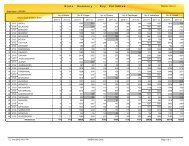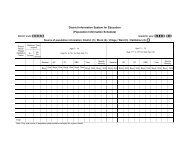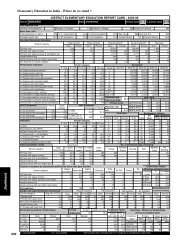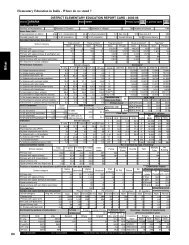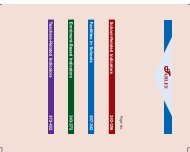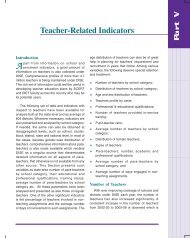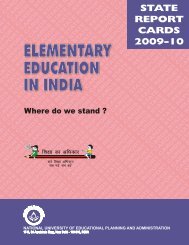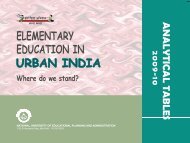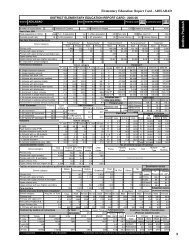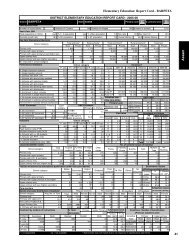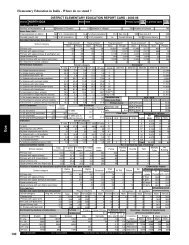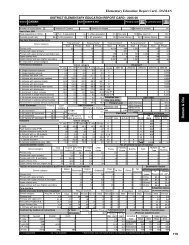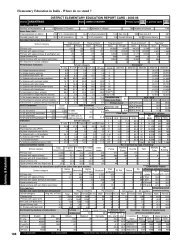Teacher Related Indicators & EDI - DISE
Teacher Related Indicators & EDI - DISE
Teacher Related Indicators & EDI - DISE
Create successful ePaper yourself
Turn your PDF publications into a flip-book with our unique Google optimized e-Paper software.
Part V<br />
Elementary Education in India : Analytical Report<br />
of universalisation. The variables used to compute the<br />
<strong>EDI</strong> in the present exercise are presented in Table E-1. It<br />
may also be noted that the <strong>EDI</strong> in India is still evolving<br />
and each indicator used have a specific purpose.<br />
However, they are not fixed and hence a review is being<br />
undertaken periodically and new indicators are added<br />
to the existing set of indicators or a few of them may be<br />
dropped or used in the modified form. In the 2007-08<br />
<strong>EDI</strong> computation, an improved version of a few variables<br />
has been used. Percentage of access-less habitation was<br />
one such variable. Similarly, in place of schools without<br />
drinking water facility, schools with drinking water facility<br />
has been used as a positive variable. In place of Gross<br />
Enrolment Ratio of SC/ST population, percentage of SC/<br />
ST population (to total<br />
population, 2001 Census) minus<br />
percentage of SC/ST share of<br />
enrolment in Primary and Upper<br />
Primary classes has been used to<br />
assess participation of the SC/ST<br />
children. As many as 23<br />
indicators have been used in<br />
computing the <strong>EDI</strong> which are<br />
further re-grouped into the<br />
following four sub-groups:<br />
Access,<br />
<br />
<br />
<br />
Infrastructure,<br />
<strong>Teacher</strong>s, and<br />
Outcome indicators.<br />
The <strong>DISE</strong> provides information on most of these<br />
indicators that have been used to compute the <strong>EDI</strong> at<br />
Primary and Upper Primary levels of education in 2007-<br />
08. Under the access indicators, two indicators namely,<br />
percentage of un-served habitations and availability of<br />
schools per thousand child population (6-11/11-14<br />
years) have been used. The projected child population<br />
provided by the Office of the Registrar General of India<br />
has been used, while the percentage of un-served<br />
habitations has been obtained from the All-India<br />
Education Survey: 2002-03. It may be noted that the<br />
latest information on un-served habitations is available<br />
only for the year 2002-03, though a number of Primary<br />
and Upper Primary schools have been opened across<br />
the county since then. Thus the same may not present<br />
the true picture with regard to the availability of<br />
“It may be noted that the<br />
<strong>EDI</strong> in India is still evolving<br />
and each indicator used have a<br />
specific purpose. However,<br />
they are not fixed and hence a<br />
review is being undertaken<br />
periodically and new indicators<br />
are added to the existing set<br />
of indicators or a few of them<br />
may be dropped or used in the<br />
modified form”<br />
schooling facility in 2007-08. However, in view of the<br />
absence of other independent source of data on<br />
coverage of habitations, except state reports, the <strong>EDI</strong><br />
continues to use 2002-03 data, which will be updated<br />
as and when independent data becomes available. In<br />
the absence of latest data, the 2002-03 data has been<br />
corrected with reference to new schools (government)<br />
opened since 2002-03. In addition, ratio of Primary to<br />
Upper Primary schools/sections has also been used as<br />
an indicator of access at Upper Primary level of<br />
education. While computing the ratio, both Primary and<br />
Upper Primary schools as well as Primary and Upper<br />
Primary sections attached to Secondary and Higher<br />
Secondary schools have been considered.<br />
The Working Group on the<br />
<strong>EDI</strong> identified five indicators<br />
under infrastructure set of<br />
indicators. The average studentclassroom<br />
ratio, percentage of<br />
schools with student-classroom<br />
ratio 60 and above, percentage<br />
of schools with drinking water<br />
facility in school and percentage<br />
of schools with common and<br />
girls’ toilet are such indicators.<br />
The third set of indicators, six in<br />
numbers, is teacher related<br />
indicators. They are: Pupilteacher<br />
ratio, percentage of<br />
female teachers, schools with PTR 60 and above,<br />
percentage of single-teacher schools, percentage of<br />
schools with less than 3 teachers and percentage of<br />
teachers without professional qualifications.<br />
The last set of indicators is related to outcome<br />
indicators among them gross enrolment ratio is the most<br />
important one. While computing the GER, projected<br />
population figures provided by the Office of the Registrar<br />
General of India have been used to workout 6-11 and<br />
11-14 year population. As already mentioned, the GER<br />
for SC and ST population, percentage difference of SC/<br />
ST population in 2001 Census and percentage of SC/ST<br />
enrolment to total enrolment at Primary and Upper<br />
Primary level of education have been used to assess the<br />
participation of SC/ST children (in case of negative<br />
difference, the same is treated to be zero; thus meaning<br />
192




